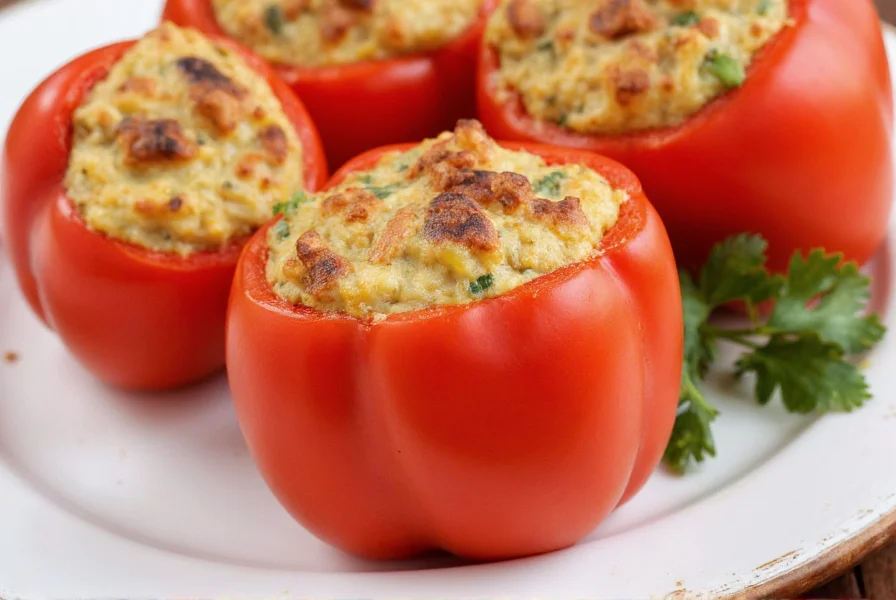Stuffed peppers represent one of the world's most universally beloved comfort foods, with variations appearing in cuisines from Hungary to Mexico. This versatile dish transforms simple bell peppers into edible vessels for creative culinary expression while delivering balanced nutrition. Understanding the fundamentals of stuffed pepper preparation ensures consistently delicious results whether you're cooking for weeknight dinners or special occasions.
The Cultural Journey of Stuffed Peppers
Peppers stuffed with various fillings have appeared in culinary traditions worldwide for centuries. Hungarian töltött paprika features ground pork with rice in a tomato-based sauce, while Greek gemista incorporates tomatoes, zucchini, and peppers filled with rice and herbs. Mexican chile relleno uses poblano peppers stuffed with cheese or meat, then battered and fried. These global variations demonstrate how stuffed peppers adapt to local ingredients while maintaining their essential character.
Essential Ingredients for Perfect Stuffed Peppers
The foundation of exceptional stuffed peppers rests on quality ingredients and proper preparation techniques. Bell peppers serve as both container and flavor component, so selecting the right specimens matters significantly.

Choosing the Right Peppers
Look for firm, glossy bell peppers with smooth skin and consistent color. Larger peppers (about 4-5 inches tall) work best for stuffing, providing ample space for fillings while maintaining structural integrity during baking. Green peppers offer the most affordable option with a slightly bitter flavor that mellows when cooked. Red, yellow, and orange varieties contain more sugar, resulting in sweeter, more complex flavors when baked.
Filling Components That Make a Difference
The ideal stuffed pepper filling balances texture, flavor, and moisture content. Key elements include:
- Protein - Ground beef, turkey, sausage, or plant-based alternatives
- Grain - Cooked rice, quinoa, or couscous for structure
- Aromatics - Onions, garlic, and celery for flavor foundation
- Binding liquid - Tomato sauce, broth, or diced tomatoes
- Seasonings - Herbs and spices that complement the protein choice
| Pepper Color | Flavor Profile | Best Filling Pairings |
|---|---|---|
| Green | Slightly bitter, vegetal | Hearty meat mixtures, robust spices |
| Red | Sweet, fruity | Ground turkey, feta cheese, Mediterranean herbs |
| Yellow/Orange | Mildly sweet | Vegetarian fillings, seafood variations |
Step-by-Step Preparation Guide
Mastering stuffed peppers requires attention to preparation details that prevent common pitfalls like soggy peppers or dry fillings.
Prepping the Peppers Properly
Cut 1/4 inch from the top of each pepper and remove seeds and membranes. Blanching peppers before stuffing creates the ideal texture balance - tender enough to eat but firm enough to hold their shape. Submerge prepared peppers in boiling water for 3-4 minutes, then transfer to ice water. This crucial step prevents peppers from becoming mushy during baking while reducing raw flavor.
Creating the Perfect Filling
Brown your protein thoroughly in a skillet, then add chopped onions and garlic until translucent. Stir in cooked grains, diced tomatoes, and seasonings. The filling should hold together when pressed but not feel dense. For optimal texture, let the filling cool slightly before stuffing peppers - this prevents premature cooking of the peppers from residual heat.

Variations for Every Dietary Preference
Modern stuffed pepper recipes accommodate diverse dietary needs without sacrificing flavor or texture.
Vegetarian Stuffed Peppers
Replace meat with cooked lentils, black beans, or quinoa for protein-rich vegetarian versions. Add umami depth with mushrooms, sun-dried tomatoes, or a splash of soy sauce. Top with feta or goat cheese for creamy contrast. For vegan options, omit cheese or use plant-based alternatives.
Low-Carb and Keto-Friendly Options
Substitute rice with cauliflower rice or chopped mushrooms to reduce carbohydrates. Increase protein content with additional ground meat or cheese. Use a tomato-broth mixture instead of sugary tomato sauces to maintain ketosis while preserving traditional flavors.
Gluten-Free Adaptations
Most traditional stuffed pepper recipes are naturally gluten-free, but always verify broth and sauce ingredients. Some commercial tomato products contain gluten as a thickener. When using sausage, check for gluten-containing fillers.
Proven Cooking Techniques for Best Results
Achieving perfectly cooked stuffed peppers requires attention to baking details that many recipes overlook.
Preventing Soggy Bottoms
Place stuffed peppers in a baking dish with 1/4 inch of liquid (broth or tomato sauce) at the bottom. Cover tightly with foil for the first 25 minutes of baking to create steam that cooks the peppers evenly. Remove foil for the final 10-15 minutes to allow tops to brown and excess moisture to evaporate.
Temperature and Timing Guidelines
Bake stuffed peppers at 375°F (190°C) for 35-45 minutes total. The peppers are done when tender enough to pierce easily with a fork but still hold their shape. Internal temperature of meat fillings should reach 165°F (74°C). Let rest for 5-10 minutes before serving to allow flavors to settle and prevent fillings from spilling out.
Serving Suggestions and Storage Tips
Complement your stuffed peppers with appropriate sides and understand proper storage for leftovers.
Ideal Pairings
Serve stuffed peppers with Greek yogurt or sour cream to balance acidity. A simple green salad with lemon vinaigrette provides refreshing contrast. For Mediterranean versions, pair with tzatziki and pita bread. Mexican-style stuffed peppers work well with avocado slices and cilantro-lime rice.
Storage and Reheating Methods
Store cooled stuffed peppers in airtight containers for up to 4 days in the refrigerator. Freeze for longer storage (up to 3 months). Reheat in the oven at 350°F (175°C) for best results - microwave heating can make peppers rubbery. Add a splash of broth when reheating to restore moisture.
Nutritional Benefits of Stuffed Peppers
Bell peppers themselves offer significant nutritional advantages that enhance this dish's health profile. One medium bell pepper provides more than 100% of the daily recommended vitamin C intake and substantial vitamin A. The combination of vegetables, lean protein, and whole grains creates a balanced meal with approximately 300-400 calories per serving, depending on the filling ingredients. Adding beans or lentils increases fiber content, promoting digestive health and satiety.
Final Thoughts on Perfecting Stuffed Peppers
Mastering stuffed peppers combines understanding ingredient interactions with proper technique. The most successful versions balance flavorful fillings with properly cooked peppers that maintain their shape while becoming tender. By selecting quality ingredients, preparing peppers correctly, and adjusting cooking methods to your specific recipe, you'll create stuffed peppers that delight with their harmony of flavors and textures. Whether following traditional recipes or experimenting with modern variations, the principles of balanced moisture, complementary flavors, and proper cooking technique remain essential for stuffed pepper perfection.











 浙公网安备
33010002000092号
浙公网安备
33010002000092号 浙B2-20120091-4
浙B2-20120091-4